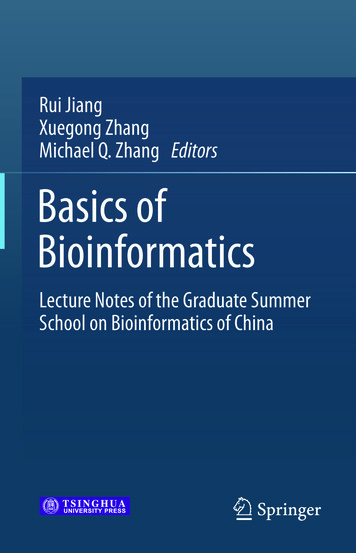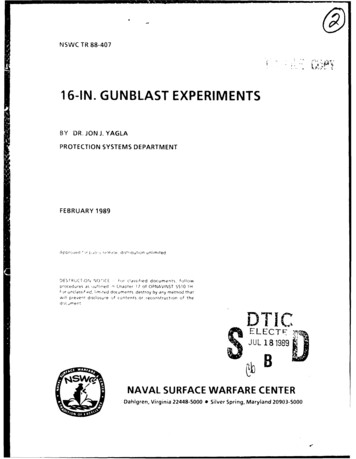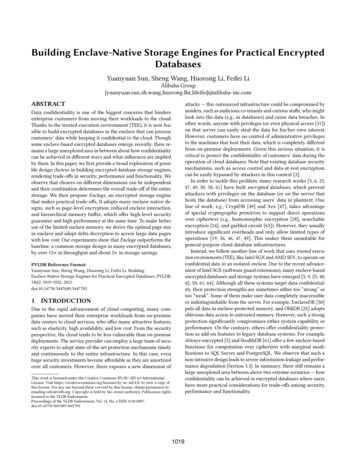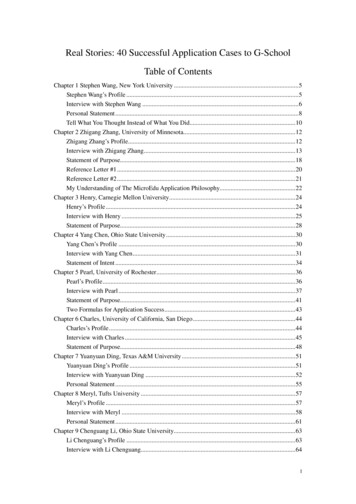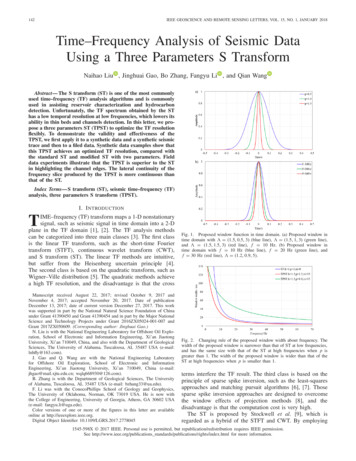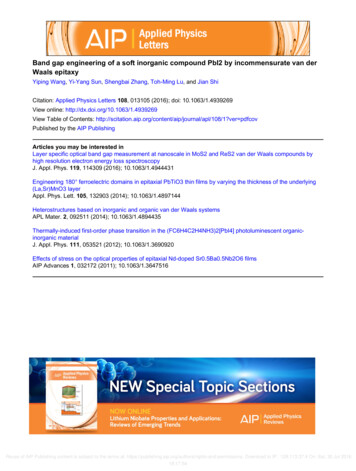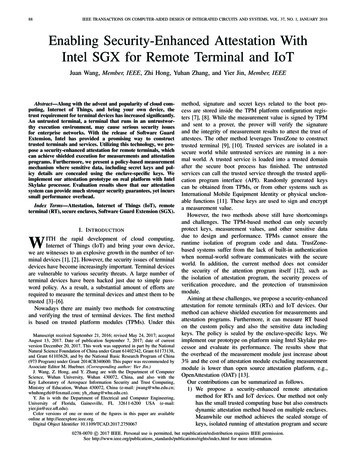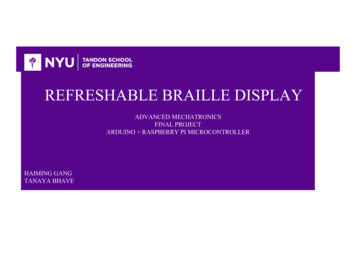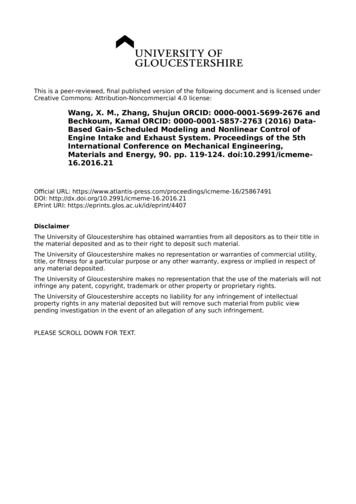
Transcription
This is a peer-reviewed, final published version of the following document and is licensed underCreative Commons: Attribution-Noncommercial 4.0 license:Wang, X. M., Zhang, Shujun ORCID: 0000-0001-5699-2676 andBechkoum, Kamal ORCID: 0000-0001-5857-2763 (2016) DataBased Gain-Scheduled Modeling and Nonlinear Control ofEngine Intake and Exhaust System. Proceedings of the 5thInternational Conference on Mechanical Engineering,Materials and Energy, 90. pp. 119-124. doi:10.2991/icmeme16.2016.21Official URL: 16/25867491DOI: http://dx.doi.org/10.2991/icmeme-16.2016.21EPrint URI: rThe University of Gloucestershire has obtained warranties from all depositors as to their title inthe material deposited and as to their right to deposit such material.The University of Gloucestershire makes no representation or warranties of commercial utility,title, or fitness for a particular purpose or any other warranty, express or implied in respect ofany material deposited.The University of Gloucestershire makes no representation that the use of the materials will notinfringe any patent, copyright, trademark or other property or proprietary rights.The University of Gloucestershire accepts no liability for any infringement of intellectualproperty rights in any material deposited but will remove such material from public viewpending investigation in the event of an allegation of any such infringement.PLEASE SCROLL DOWN FOR TEXT.
Advances in Engineering Research, volume 905th International Conference on Mechanical Engineering, Materials and Energy (ICMEME 2016)Data-Based Gain-Scheduled Modeling andNonlinear Control of Engine Intake and Exhaust SystemXiaoming Wang1*, Shujun Zhang1 , Kemal Bechkoum11School of Applied Computing and Technology, University of Gloucestershire,Cheltenham GL50 2HR, UK, Email:xiaomingwang@connect.glos.ac.ukKeywords: Model-Based Design, Exhaust Gas Recirculation, Variable Geometry Turbocharger,Emissions, Optimization, Gain-Scheduled.Abstract. In this paper, the parameterized dynamical model of the diesel engine intake and exhaustsystem using a data-based method, namely a Gain-Scheduled model is proposed and designed basedon the data from a virtual engine test bench under normal load conditions. In the first step, theMultiple Input Multiple Output model structure is defined with five inputs and two outputs. Usingthe constructed model, it is possible to establish the relations between intake Manifold Pressure, AirMass Flow, the control signals, and changes of the load. Then, the model is further used to design aNonlinear Model Predictive Control controller, aimed at optimizing the efficiency of thecombustion system in terms of the control reference value tracking with respect to emissionreduction. This paper follows a model-based design approach to construct the Nonlinear ModelPredictive Control objective function for the engine intake Manifold Pressure and Air Mass Flownonlinear control problem. The proposed data-based dynamical modeling method is shown toincrease the flexibility for the modeling of nonlinear plant at a low cost in computationalrequirements. The experimental results illustrate that the optimized nonlinear control approachsignificantly improve the control reference tracking performance and the exhaust emissions againstthe standard decentralized Single Input Single Output control in the standard production EngineControl Unit.IntroductionThis study is motivated by the necessity of improving the performance of diesel engines andreducing their emissions. Research in [1] has shown that both Exhaust Gas Recirculation (EGR)system and Variable Geometry Turbocharger (VGT) are driven through the exhaust gas, thus thereis a strong coupling between the two systems. However, in the standard production Engine ControlUnit (ECU), the control strategy remains based on gain scheduled Proportional–Integral–Derivative(PID) plus feed forward control for the EGR and VGT, wherein boost pressure is controlled withVGT and the mass flow through the turbine is controlled by the EGR valve. With such a controlsystem, the control performance for transient tracking and adjusting is insufficient, because theeffects from the VGT position on the air mass flow and from the EGR rate on the boost pressure areignored. With transients, the control objective has to provide sufficient Air Mass Flow (MAF)charge at the pedal tip-in such that enough fuel can be burnt without visible smoke to provide thedemanded torque while avoiding so called turbo-lag [1]. Moreover, at the same time sufficient recirculated gas is needed to reduce nitric oxide (NOx) and particulate matter (OPAC) emissions.Therefore, the current study proposes and develops an advanced control approach namely,Nonlinear Model Predictive Control (NMPC), for diesel engine intake and exhaust system togenerate as much energy as possible per fuel injection while keeping pollutant emissions below agiven threshold.Copyright 2016, the Authors. Published by Atlantis Press.This is an open access article under the CC BY-NC license 19
Advances in Engineering Research, volume 90Model-Based Control DesignThe design of automotive controls has become increasingly complex and expensive due toseveral factors 1) the increasing variety of variants of a base engine calibration version; 2) thedecreasing availability of test objects (engine, vehicle); and 3) increasingly strict requirementsconcerning consumption, emissions, and diagnostics. The increasing complexity of the task can nolonger be handled using classical methods of controller design [6]. Even if automating controllerturning processes, a series of tasks must be iteratively executed: 1) measurement and variation ofcontroller parameters; 2) measurement of responses of the experimental plant with a vehicle andengine; 3) analysis of measurements; 4) step-by-step optimization on the test bench. For modelbased control design, one measurement on the real system is sufficient (after creating theexperiment plan) [6]. Further steps are performed on the numerical model: 1) control parameterscan be changed and the resulting behavior can be predicted in simulation; 2) depending on thespecification, optimal results can be achieved.Model-Based Multiple-Target OptimizationIt is well known in engine application that emissions optimization is a true multiple-targetoptimization that leads to a set of Pareto-optimal solutions [6]. At that point, the selection of thesolution can also be performed by means of some criteria (e.g. trade-off between NOx and OPAC).Here the optimization procedure is carried out simultaneously using a simulation model at alloperating points. The results are calibration maps as is the case with successive optimization atseveral Operation Points (OPs). Regarding the target criteria, driving cycle data as well assmoothness of the resulting maps can be considered. In this paper, the optimization problem istransformed into following relationship as in Eq.1. The contribution of a component to the targetweights can be adapted to individual requirements.()( ())( )(1)Nonlinear Model Predictive Control (NMPC)Model Predictive Control (MPC) is a control approach in which a current control signal iscalculated by solving an optimization problem. The optimization problem is solved by predictingthe future system output using a model of the plant. The model can be a state space system, transferfunction, or any other representation. A large challenge in implementing an NMPC is the need of anaccurate nonlinear model. In this work, a Gain-Scheduled modeling approach is used. Thisapproach is introduced in a previous study, [2], under the term parameter varying. The model isrelated to a Gain-Scheduled structure which separates the working area of a nonlinear plant inseveral regions. For each of these areas linearized models must be evaluated. With this approach,the nonlinear identification problem is transformed into a quasi-linear relationship:()(()(2))where y, x and u are the output, state and input of the system; A, B, and C are the system matrixes;denotes the modeling error; and is the gain scheduling parameter.This Gain-Scheduled model provides increased prediction accuracy compared to the linear case.In a discrete time case, the system input space is expanded with feedback from past input and outputvalues up to a certain time horizon, as shown in Eq. 3. The NMPC principle is characterized by thefollowing cost function:120
Advances in Engineering Research, volume 90 ()() (3)where PH and CH denote the prediction horizons and control horizons, respectively; and Q and Rare the weight factors. Detailed researches about NMPC can be found in [3, 4, and 7].Application: Nonlinear Model Predictive Control of Engine Intake and Exhaust SystemFigure 1. Engine layout, Variable Geometry Turbocharger and Exhaust Gas RecirculationSystem Description and Control Objectives. As shown in Fig. 1, this is a common configurationin many modern engines for a power vehicle system, especially when high performance is required.The reduction of fuel consumption and the regulated emissions of components is one of the mostimportant issues in engine development. A significant contribution to these goals can be deliveredby EGR and VGT actions according to given reference values of Manifold Pressure (MAP) andMAF. However, the extreme nonlinearity of the combustion system makes it difficult to accuratelycontrol the VGT and EGR actuators. Then questions arise, why are MAF and MAP the onlyvariables of interest? The reasons for this are widespread. The aim of modern engines is theminimization of fuel consumption while providing the demanded torque and keeping emissionsbelow legal limits. One approach would be to use emission quantities (e.g. NOx and OPAC) in thecontrol algorithm. However, the online measurement of these variables is not currently possible in aproduction engine and the use of online emission models is in a developmental phase [5]. Theremust be quantities which, on the one hand, can be easily measured, and on the other correlate toemissions. Until now, MAP and MAF are the two most popular quantities [1, 5].Engine Intake and Exhaust System Modeling. To optimize the engine system efficiency asdescribed by MAP and MAF control tracking and emissions reduction, an advanced controlapproach NMPC is necessary. To design and tune such a control system, a real time preciseprediction model must be developed, thus the system is identified with the Gain-Scheduledapproach. The chosen inputs for the identified model with feed forward input selection are: ExhaustPressure (Pex), EGR valve position (Xegr), VGT valve position (Xvgt), engine speed (n), and fuel121
Advances in Engineering Research, volume 90injection (mf). The outputs are MAF and MAP. This system is identified in one step with a MultipleInput Multiple Output (MIMO) structure to determine the interactions between all inputs andoutputs. The identification of MAP and MAF highly depends on the special behavior of input andoutput signals, therefore in this case, a preprocessed Federal Test Procedure (FTP) -75 driving cyclemeasurement is prepared as the identification and validation data set. The model is then identifiedusing the previously discussed Gain-Scheduled identification approach. Fig. 2 presents acomparison of the measured data and the simulation results based on the identified models. It can bededuced that the Gain-Scheduled model could give good identification precision results.Correlation "out maf mgst" (RMSE 14.8485, RQ 0.99748)Correlation "out map mbar" (RMSE 42.2506, RQ 0.9983)1600out map mbar (predicted)1500900Data visible (100.0%)Ideal correlation2% error (42.7% outside)5% error (27.6% outside)10% error (0.1% outside)25% error (0.0% outside)800out maf mgst (predicted)170014001300120011001000700Data visible (100.0%)Ideal correlation2% error (70.2% outside)5% error (42.7% outside)10% error (3.0% outside)25% error (0.0% 01200out map mbar (measured)125013001350100150200250300350400450out maf mgst (measured)500550600650Figure 2. Validation of model outputs of Air Mass Flow and Manifold PressureFigure 3. Optimized reference values of Air Mass Flow and Manifold PressureNonlinear Model Predictive Control of Engine Intake and Exhaust System. The combustionengines manufactures must be able to prove that legally prescribed thresholds for emissions areadhered to (e.g. in accordance with the Euro 6 standard) in various test cycles [6]. The task ofoptimization is thus both to adhere to these thresholds and attain the best possible consumption rateswhile subject to any other constraints, such as thresholds for pressure and temperature. Some drivecycles are prescribed by the legislator as a list of stationary operation points, others are defined astransient drive cycles via speed and load. To make reliable predictions about dynamic results from122
Advances in Engineering Research, volume 90stationary information, it is a common practice to reduce the transient drive cycles to a list ofoperating points that are as representative as possible [6]. In this case, the optimized referencevalues of MAP and MAF, according to minimized emissions, are shown in Fig. 3.Figure 4. Nonlinear Model Predictive Control closed loop control structure5020OPAC(norm) [%]NOx(norm) [%]403020100760770780Time [s]790Optimized NMPCECU151050760770780790Time [s]Figure 5. Comparison of exhaust emissions of nitrous oxide and particular matterAs discussed, the chosen controller design is an NMPC controller design to determine asuboptimal robust control. The algorithm of the implemented NMPC is integrated with a matlabprogrammed real time quadratic problem (QP) solver, by calculating different discrete solutionregions and choosing the best within the limits of prescribed tolerances. The closed loop controlstructure is depicted in Fig. 4. For a comparison between the performance of optimized NMPC and123
Advances in Engineering Research, volume 90ECU, experiments were performed with identical conditions. The results of this closed loopsimulation are presented in Fig. 5 and 6.2001800ReferenceOptimized NMPCECU17001600MAP [mbar]MAF ime [s]420900390400410420Time [s]Figure 6. Comparison of tracking results of Air Mass Flow and Manifold PressureConclusionStudies have shown that a large operation point changing value leads to a transient state,increasing the emissions. Therefore, optimizing and maintaining control tracking results under thegiven references are the main task in engine control. In this research, the transient behavior causedby operation changes was approximated with a dynamic model, identified with a Gain-Scheduledapproach. The excitation of the engine was completed under closed loop conditions. The results, asshown in Fig. 5 and 6, clearly show that the optimized NMPC approach has a corresponding set ofadvantages over the standard ECU control as it achieves the better reference tracking performanceand lower emissions. Another important fact is that the proposed model-based optimization methodis offline and would not require changes in the current structure of the control hardware. Howeverthe disadvantage is the large amount of memory required to store the control laws and description ofthe polyhedral partition. If the number of regions is high, the computing time necessary todetermine the proper control law must not be neglected. That should be improved for futureresearch.References[1] M. J. Nieuwstadt, I. V. Kolmanovsky, EGR-VGT control schemes: Experimental comparisonfor a high-speed diesel engine, IEEE Control Systems Magazine, 2000, pp. 63-79.[2] X. Wang, A. Steiner, Linear Parameter-Varying Modeling of Electric Vehicle Air ConditioningSystem, Applied Mechanics and Materials, 2012, pp. 318-325.[3] E. Camacho, C.Bordons, Model Predictive Control, London: Springer (2013)[4] R. Findeisen, F. Allgoewer, An Introduction to Nonlinear Model Predictive Control, Stuttgart:University of Stuttgart (2006)[5] P. Langthaler, Model Predictive Control of a Diesel Engine Air Path, Linz: University Linz(2007)[6] ETAS, ETAS ASCMO User's Guide, Stuttgart : ETAS GmbH (2016)[7] X. Wang, A Design Framework for Predictive Engine Control. Oil & Gas Science andTechnology – Rev. IFP Energies nouvelles, 2012, pp. 599-612.124
Nonlinear Model Predictive Control (NMPC) Model Predictive Control (MPC) is a control approach in which a current control signal is calculated by solving an optimization problem. The optimization problem is solved by predicting the future system output using a model of the plant. The model can be a state space system, transfer
